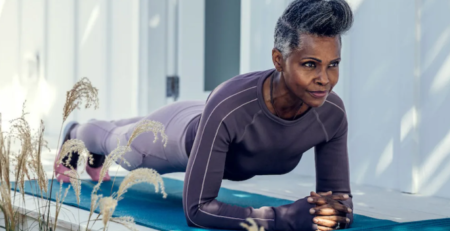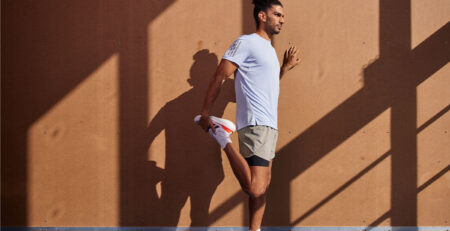Post-Run Yoga for Runners | BODi
Yoga and running are like two peas in a pod. Runners who take time to stretch (such as with post-run yoga) benefit from increased mobility and flexibility. Yogis who run build cardiovascular endurance and aerobic capacity.
Running is repetitive and high-impact, and it mostly targets the muscles of the lower body. Yoga is dynamic and lower-impact, and it works the upper and lower body, as well as the core.
While yoga does teach equanimity, there’s a right way and a less-right way to combine yoga and running to get the most out of both workouts.
Keep reading to learn the best way to combine yoga and running, a couple of pitfalls to avoid, and a few post-run yoga poses to add to your routine.
Is It OK to Do Yoga After Running?
It’s absolutely OK to unroll your mat after a run, says yoga instructor Kayla Preston, E-RYT 200, YACEP.
In fact, it’s better to save yoga for after you log your miles for the day, “as you want to warm up and strengthen your supporting muscles” with dynamic stretches and movements rather than static ones.
“It is beneficial to do yoga or more stretching-based exercises after running,” she advises.
What Type of Yoga Should You Do Post-Run?
With so many different types of yoga, which is the best post-run yoga? Stick with gentler or restorative yoga. Save the intense Ashtanga or steamy Bikram for another day.
“After a run, your body will be tired,” says Preston. And don’t forget to hydrate!
If you’re following our Yoga52 program, choose level 1 classes or shorter sessions for after your run.
How Long Should My Yoga Session Be Post-Run?
There’s no prescribed length of a post-run yoga sesh. Instead, listen to your body. Aim for 10 minutes up to an hour, says Preston, depending on the distance you ran and your current fitness level.
If you’re a seasoned runner who does a short route every day, you can totally do both daily.
“If you are running long distance, you may start to alternate your running and yoga or other exercises to avoid overworking your body,” says Preston.
Yoga is great active recovery. That whole mind-body connection that yoga builds really comes in handy here.
To progress in your practice and build muscle memory, Preston suggests combining yoga and running at least three times a week.
What Yoga Poses Should You Do Post-Run?
Runners often get tight in the legs, hips, and lower back. Give attention to your calves, quads, hamstrings, and glutes during post-run yoga so that you can get back to hitting the pavement (or treadmill!) sooner.
Yoga instructor and alignment coach Jennifer Fuller suggests starting with a 10-minute post-run yoga session, holding each pose for 30 to 90 seconds. This gives you time to cool the body down, alleviate tension, and loosen up.
Here are a few of our favorite post-run yoga poses.
1. Happy baby (Ananda Balasana)
- Lie on your back. Keep your hips on the floor, then hug your knees to your chest.
- Reach between your thighs to capture the instep of your feet or your ankles. You can hold your calves if your hips feel tight.
- Rest your head on the mat. Stare at the ceiling.
- Relax and rock side to side if desired.
2. Child’s pose (Balasana)
- Start on all fours, with your hands directly below your shoulders and your knees hip width or wider. Bring your big toes together.
- Exhale and sink your hips back toward your heels. Rest your belly between your thighs and your forehead on your mat.
- Extend your arms out in front of you (palms down, to stretch the whole back) or along your sides (palms up, to stretch between the shoulders).
3. Lizard pose (Utthan Pristhasana)
- Begin in downward facing dog. Inhale your right leg high for three legged dog. Exhale to step your right foot between your hands for a low lunge.
- Shift your right hand on the inside of your right foot. Scoot your right foot to the edge of your yoga mat. Keep your right knee aligned over your ankle. Plant your right foot into your mat.
- Keep your shoulders stacked over your wrists or drop down to your elbows for a deeper stretch.
- Lengthen your back leg long and straight. Squeeze your glutes to keep your hips squared. Push the backside of your knee toward the ceiling to engage your leg muscles. You have the option to drop down to your back knee for a passive stretch.
- Gaze down toward your mat.
- Hold for as long as you’d like, then move through Downward Facing Dog and repeat on the other side.
4. Seated wide-leg forward fold (Prasarita Padottanasana)
- Take a seat. Rotate your body so that you face the long edge of your mat.
- Separate your legs until they are wider than hip-width (think a wide “V” shape). Straighten your legs — it is OK if your knees bend. Flex your feet to deepen the stretch.
- Stay upright with your shoulders stacked over your hips or walk your hands forward, folding your body in half.
Disclaimer: all images are owned and copyright by their respective owners and website (www.beachbodyondemand.com) and “https://madcity.fitness/blog” is for news, information, product news and reviews.








